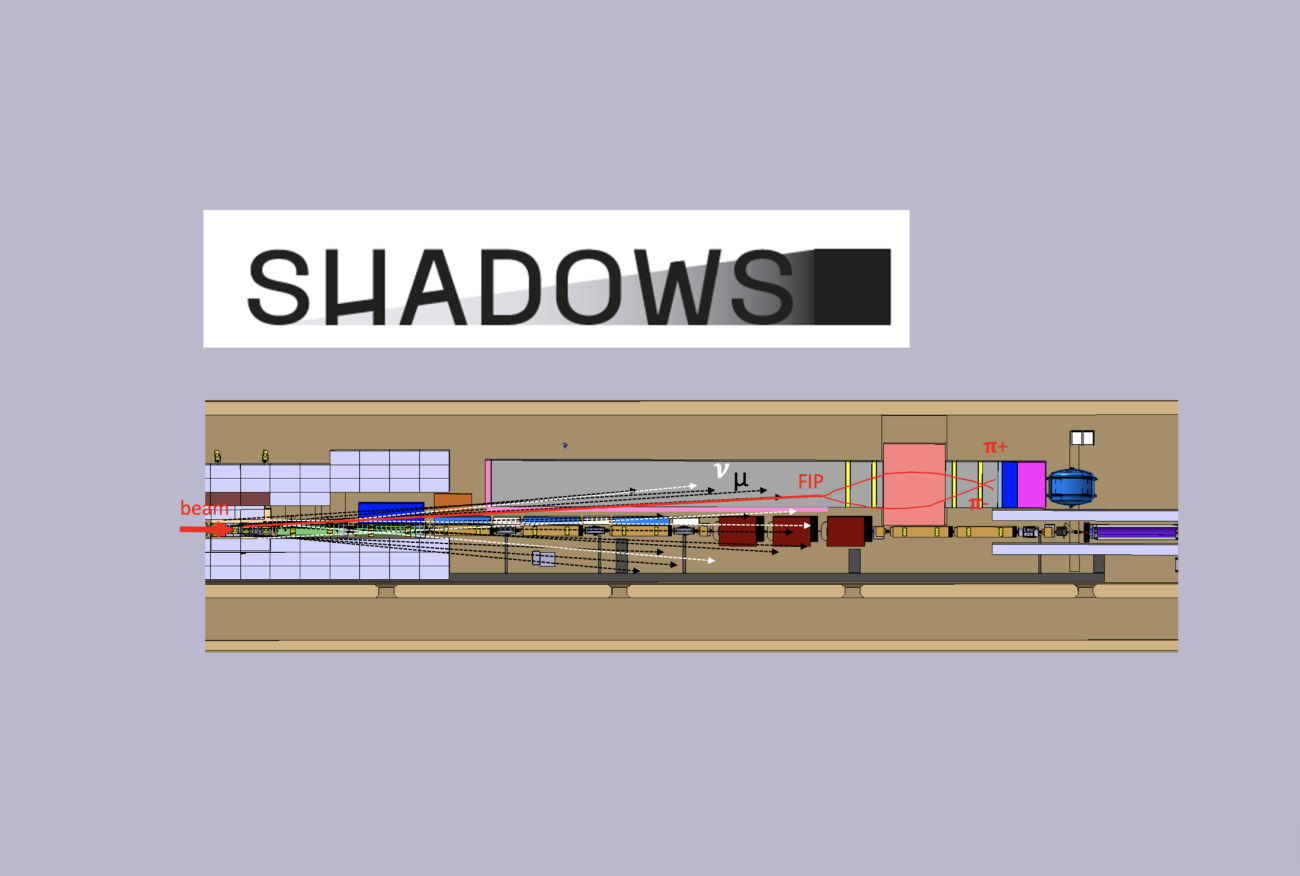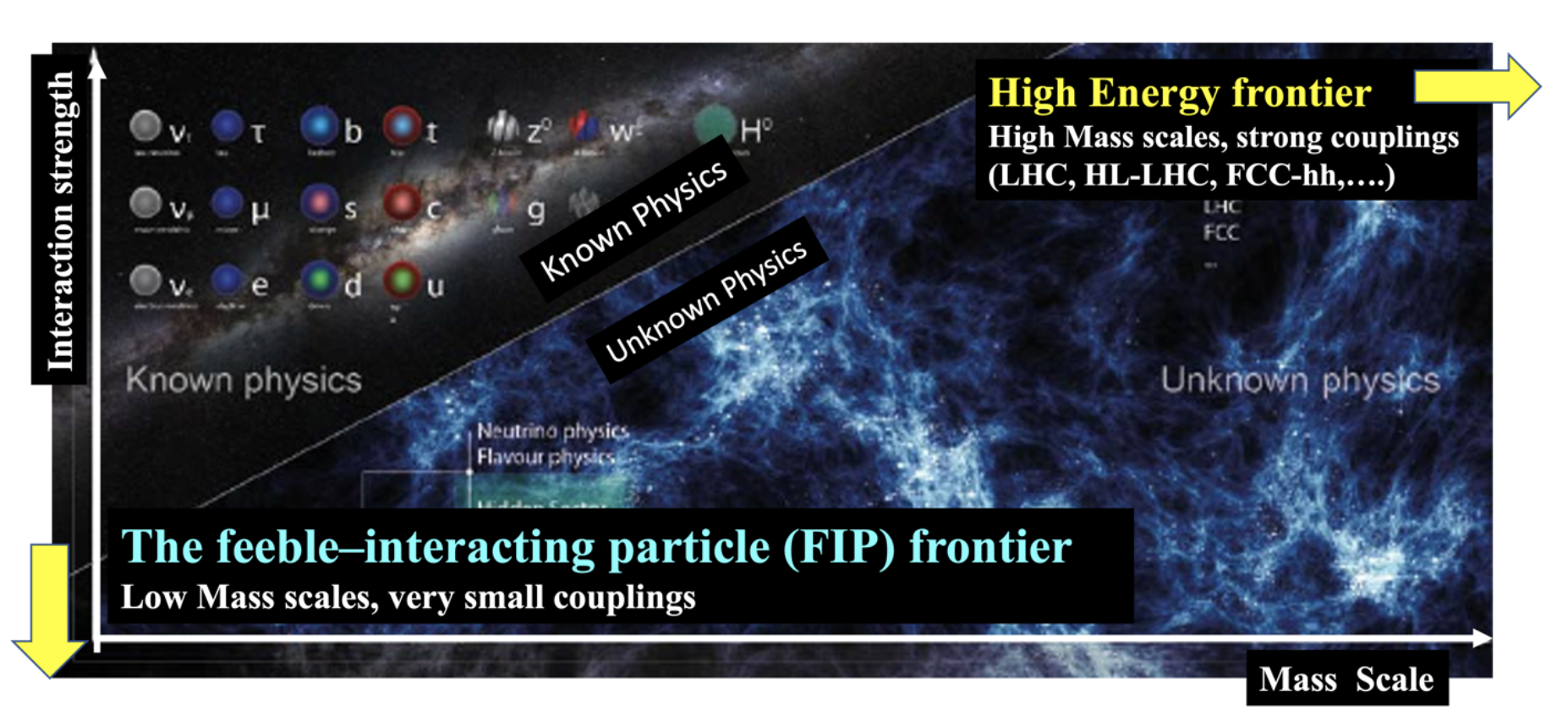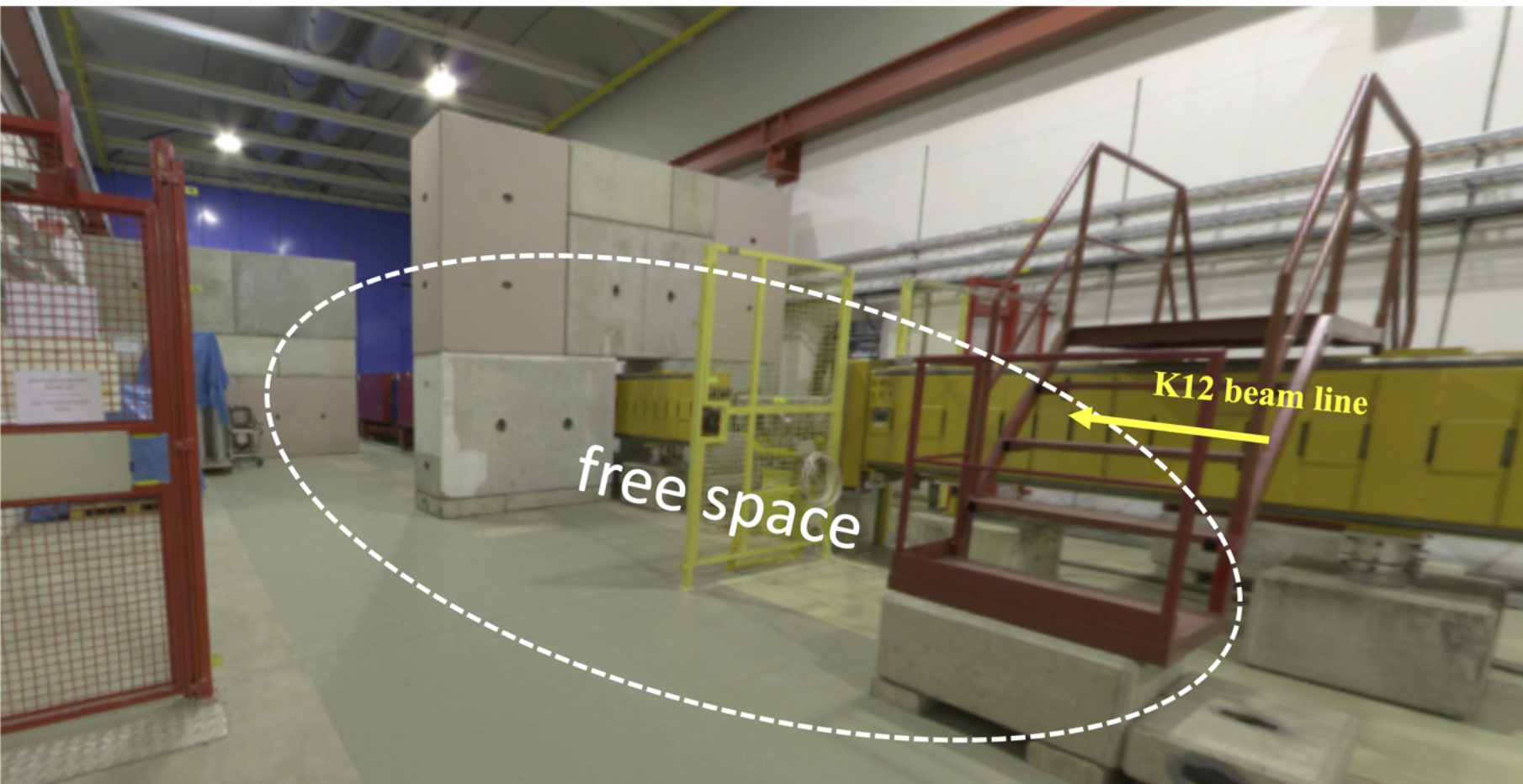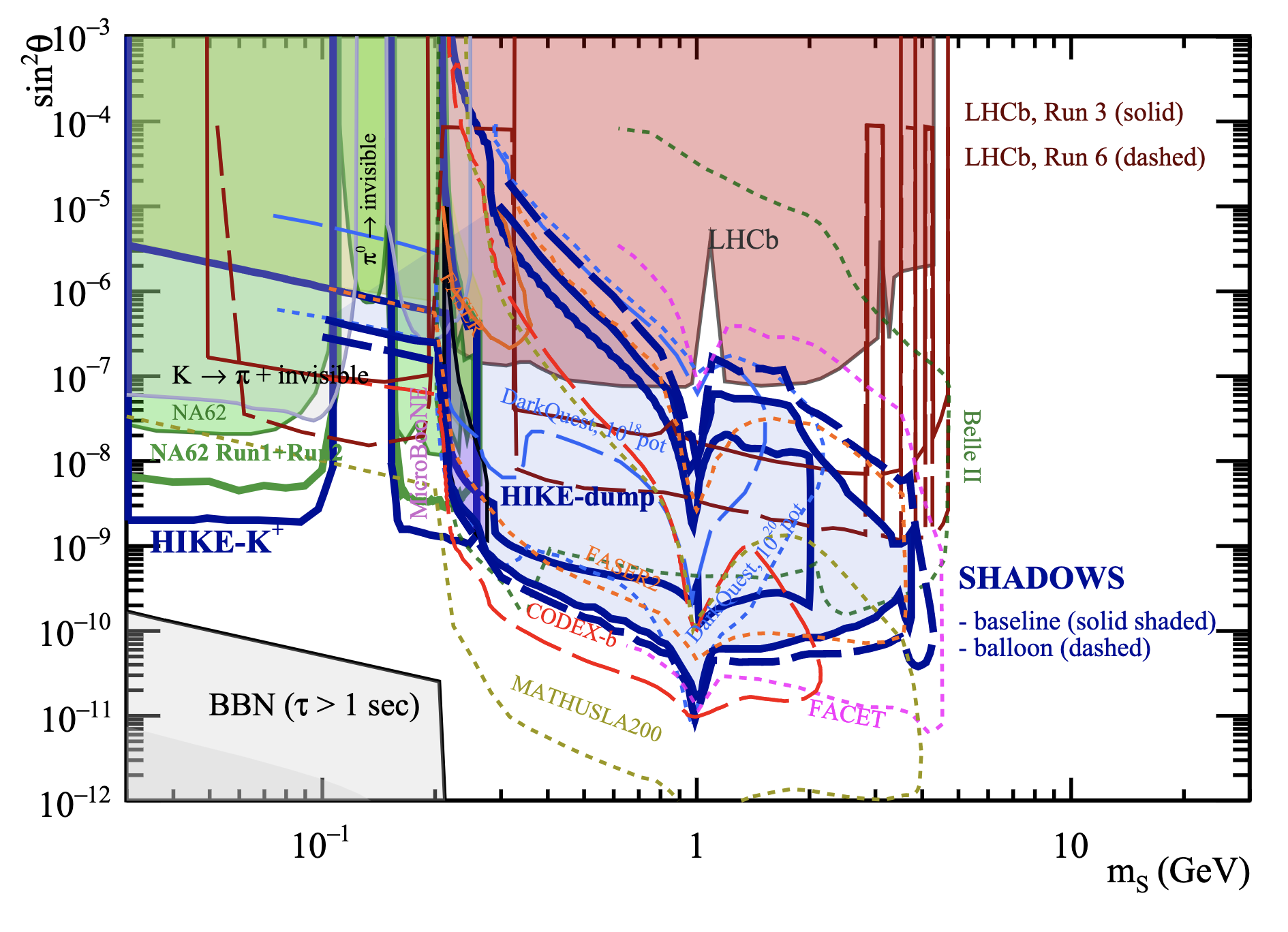SHADOWS of New Physics in the CERN North Area

In recent years, the physics of feebly-interacting particles (FIPs) has received considerable and growing attention from the broad HEP community, motivated by both existing data, and by the appeal of simple extensions of the Standard Model to address long-standing puzzles in which FIPs play an important role. These are, among others, the baryon asymmetry of the universe, the nature of dark matter (DM), the origin of the neutrino masses and oscillations, the cosmological inflation, the strong CP problem, and the hierarchy of scales [1,2].

Figure 1: Two possible ways of searching for New Physics: The Energy frontier and the Feebly-interacting particles (FIPs) frontier.
The importance of FIPs searches has been clearly stated by the recent recommendations of the European Strategy for Particle Physics (ESPP) Update [3] that includes the physics of feebly interacting particles among the “essential scientific activities” for particle physics to be pursued in the next decade.
FIPs are shadows of New Physics, due to their extremely rare production rates and their long lifetimes, that make them difficult to detect at standard HEP experiments. That is why they require dedicated experiments. While the search for FIPs in a broad mass range is interesting, special focus has been placed on the relatively poorly explored MeV-GeV scale.
SHADOWS (Search for Hidden And Dark Objects With the SPS) aims to be a major player in the search for FIPs of exactly these masses. It will exploit the upgraded infrastructure and accelerator complex in the ECN3/TCC8 experimental area for the high intensity phase, that will be consolidated and upgraded during the next long shutdown (LS3). SHADOWS will take data concurrently with HIKE, the NA62 successor, when the beamline is operated in beam-dump mode and integrate 5 x 1019 protons on target in four integrated years of data taking.
The main idea behind the SHADOWS experimental layout can be summarized in a few words: “Stay close and stay off-axis”. “Stay close” to the dump to maximize acceptance for FIPs emerging from heavy quarks decays with a certain polar angle, and “stay off-axis” to minimize the background emerging from the dump, mostly muons and neutrinos, that are produced in the forward direction.
“I was struggling since months for finding how to improve the NA62 geometrical acceptance for FIPs”, says Gaia Lanfranchi from INFN, “when an image came to my mind: the space near the NA62 dump…” This was the beginning of SHADOWS.

Figure 2: SHADOWS location in the TCC8 tunnel.
After a few months, in January 2022, the Expression of Interest [4] was submitted to the SPS Committee. The young collaboration, composed today by about 80 scientists from 16 different Institutions, almost tripled in the just 20 months that separated the EoI from the submission of the Technical Proposal [5] in October 2023. This rapid expansion shows the profound interest of the community for FIPs and the appeal for the new generations of a medium-size experiment with a short timescale. “The design of the detector has been done by a team of highly motivated young researchers” says Gaia Lanfranchi, “for me has been really exciting to see how the experiment took shape in such a short time under their hands”. The Technical Proposal is currently under scrutiny by the SPSC and a decision about its possible approval is expected by March 2024. If approved, SHADOWS aims to start data taking in 2030.

Figure 3: Rendering of SHADOWS in the TCC8 tunnel.
Catching shadows from the dark Universe
When searching for extremely elusive signals, the control of the background is the “name of the game”. The ways of controlling it must be reliable, powerful, and redundant. The main background is made of muons and neutrinos emerging from the dump. The first step was to design an efficient muon sweeping system, able to free the SHADOWS decay volume from the muon background, without interfering negatively with HIKE. The design of such a system was a delicate issue, complicated by the tight space available in the SHADOWS location in the TCC8 tunnel. “This took several months of work, but at the end the solution was excellent: a system of magnetized iron blocks could make the job”, says Florian Stummer, from CERN EP-EA-LE. But this was not enough, as a fraction of muons still reached the decay volume. “That is why we proposed to instrument the upstream and lateral part of the decay vessel with resistive micromegas with pad readout”, says Paolo Iengo from INFN, “a detector technology we are developing since few years, for which SHADOWS will be the first application at large scale. Moreover, the lateral part, where space is an issue, has an innovative design based on flip-flop wings”. And space is a real issue for SHADOWS integration given the extremely narrow area in the TCC8 tunnel where it will be installed. All the challenges were overcome with a thorough engineering study done by Lukasz Krempzek from CERN. The tracker is the heart of the experiment, given its double role of tracking and vertex detector. “A solution with straw tubes of 10 mm diameter and x and y views, seemed adequate and fully realistic”, says Sebastian Bachmann from Heidelberg University. “Simulations show that a vertex and an impact parameter resolution of a few mm over ~20 m decay volume seems achievable.”

Figure 4: FIP emerging from the dump together with the muon and neutrino backgrounds.
A timing detector with less than 100 ps time resolution is a key element to reduce the muon combinatorial background. “A detector based on scintillating bars with direct SiPMs readout allows matching the requirements”, says Ulrich Parzefall, from Freiburg University. The detection of FIPs decaying into fully neutral final states, such as ALP → γγ, requires an electro-magnetic calorimeter with pointing capabilities, to reconstruct the decay vertex. “A solution with scintillating strips has been found to be fully adequate to this purpose”, says Rainer Wanke from Mainz University. The detector is completed with a muon system with good timing capabilities. Given the relatively low rate seen by SHADOWS, a software-only based trigger approach can be used. “The TDAQ will be in common with HIKE, they will share the same infrastructure and technologies”, says Enrico Gamberini, from CERN-EP-DT. Radiation for an experiment so close to the dump is an issue, both for safety reasons and for the impact on electronics. “Detailed simulations with FLUKA showed that the radiation can be kept under control by an adequate shielding of the target area”, says Claudia Ahdida, from the CERN radiation protection group. All these elements have been folded in a detailed Monte Carlo simulation. “This was not an easy task, but at the end we found a way to keep all the background sources under control”, says Stefano Rosati from INFN-Rome1.
In addition to the FIP programme, a compelling neutrino programme can be pursued with NaNu (North Area NeUtrino detector), a SHADOWS sub-detector dedicated to neutrino physics. “NaNU could perform the first observation of the anti-neutrino τ, the only particles of the Standard Model for which a direct observation is still missing, and make precise measurements of neutrino cross-sections in a phase space complementary to the one explored at SND@LHC and FASER experiments, currently running at the LHC”, says Matthias Schott, from Mainz. “The ECN3 area offers also this possibility”.
Looking into the future
In the next ten years, a multitude of new initiatives (or upgrades of ongoing experiments) will produce a large set of results applicable to FIP and dark sector physics. In parallel, ongoing theoretical work is providing guidance regarding regions of parameter space in minimal models that deserve special attention. Advanced calculations of FIP production and decay rates, and the inclusion of more complete bounds from astrophysical and cosmology data, will all be important for properly interpreting the wave of new data expected in the coming years.
SHADOWS and HIKE running simultaneously and covering complementary ranges in the FIP parameter space, above and below the kaon mass, will play a major role in becoming a hot spot for FIP physics in the worldwide landscape.

Figure 5: SHADOWS and HIKE sensitivity for a light dark scalar mixing with the Higgs
The possibility of exploring new light and feebly-interacting phenomena and, simultaneously, very high-scale masses through precision measurements in the kaon sector, makes the combined SHADOWS + HIKE system unique worldwide.
The upgrade in intensity of the P42 beamline would allow CERN to have a world-class facility with several experiments running concurrently and covering a broad spectrum of very diverse physics topics. In our view, this is crucial for the future of particle physics.
References
[1] A. Antel et al., Feebly Interacting Particles: FIPs 2022 workshop report, arXiv: 2305.017015 [hep-ph].
[2] G. Lanfranchi, M. Pospelov, P. Schuster, The Search for Feebly Interacting Particles, arXiv:2011.02157 [hep-ph], Ann.Rev.Nucl.Part.Sci. 71 (2021) 279-313.
[3] European Strategy for Particle Physics Update 2020: Recommendations, in https://cds.cern.ch/record/2721370/files/CERN-ESU-015-2020%20Update%20European%20Strategy.pdf.
[4] SHADOWS coll., SHADOWS Expression of Interest, https://cds.cern.ch/record/2799412/files/SPSC-EOI-022.pdf, CERN-SPSC-2022-006 / SPSC-EOI-022.
[5] SHADOWS coll., SHADOWS Technical Proposal, https://cds.cern.ch/record/2878470/files/SPSC-P-367.pdf, CERN-SPSC-2023-029 / SPSC-P-367.
